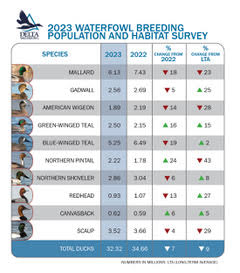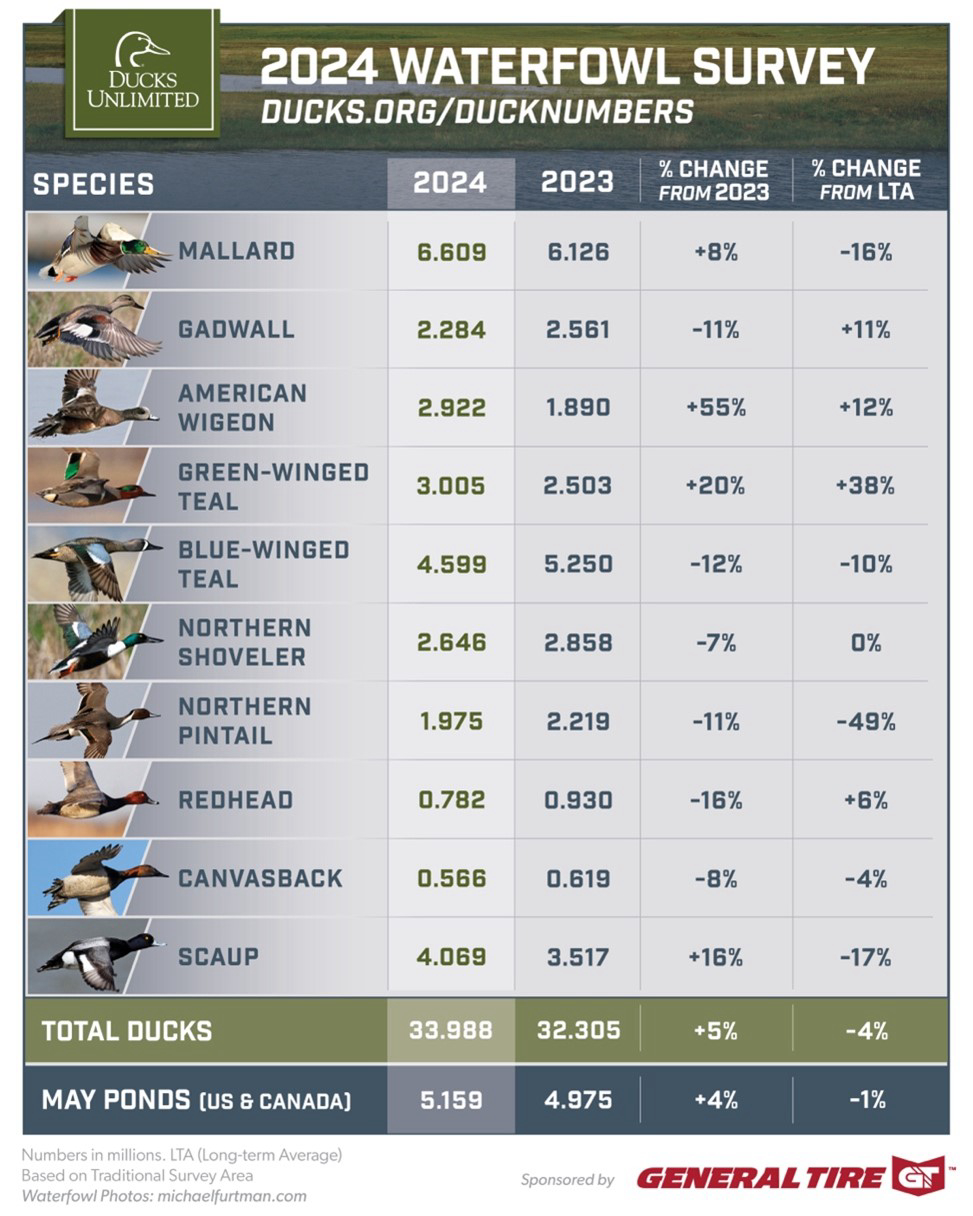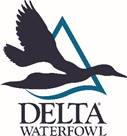Delta Waterfowl Forecasts a Reduced Fall Duck Flight

BISMARCK, NORTH DAKOTA
Delta Waterfowl has analyzed and interpreted wetland conditions reports from the organization’s field researchers and the U.S. Fish and Wildlife Service pilots who conducted the annual survey of breeding ducks and habitat. Throughout many areas of the critical breeding habitat, spring pond conditions can be summarized by one word: dry.”A remarkably high number of returning ducks had to compete for a remarkably low number of wetlands,” said Dr. Frank Rohwer, Delta Waterfowl president and chief scientist. “That doesn’t mean good things for duck production.”
The Waterfowl Breeding Population and Habitat Survey, a joint effort of the U.S. Fish and Wildlife Service and Canadian Wildlife Service since 1955, has traditionally been released in late June or early July. However, the USFWS has changed its process for setting season frameworks. The 2016-2017 seasons were set earlier this spring, using data from the 2015 survey. The results of the 2016 survey — which will affect frameworks for the 2017-2018 season — are scheduled for publication in early August.
While the size of the breeding population is important, the fall flight — which consists of the breeding population plus juvenile ducks — is more important for hunters. Duck production, which is the number of young ducks produced each spring, drives the fall flight and can make or break a waterfowl season.
“Incredible duck production, which results in high numbers of decoy-vulnerable juveniles, is what leads to incredible duck seasons,” Rohwer said. “This spring’s dry conditions indicate we’ll be hunting flocks with more adult ducks in them this fall.”
The initial driver of duck production is available wetland habitat. After a below-average winter snowpack and dry, mild spring, Delta expects the annual breeding survey’s May pond count to fall below the long-term average for the first time since 2008, when the count was 4.43 million.
“We haven’t seen a below-average pond count in a long, long time,” Rohwer said. “I think we could decline from last year’s count of 6.3 million to fewer than 4 million, which we haven’t seen since 2003. Dry conditions almost certainly led to a lower initial nesting effort, a substantially reduced renesting effort and lower duckling survival in many areas of the breeding grounds. May and June rains in parts of Alberta, Saskatchewan and North Dakota probably helped in some local areas, but not enough to offset the overwhelmingly dry conditions when the ducks returned this spring.”
According to observations by Delta biologists, and by USFWS pilots (which can be found online at flyways.us), dry conditions were most severe across the vital prairie grasslands of the Dakotas and southern edges of Alberta, Saskatchewan and Manitoba. Conditions improved to average across much of Canada’s parkland habitat farther north.
“While the parklands fared better with water this spring, we know after decades of research that nest success there is chronically low, so duck production is often weak,” Rohwer said.
Low pond counts can also decrease breeding population estimates, as species including mallards and pintails will overfly the dry prairies and settle farther north in the boreal forest and lightly surveyed areas. Fortunately, the record breeding population estimate in 2015 and moderate duck production last year should help minimize the declines.
“The total duck estimate should remain strong,” Rohwer said. “Last year, the overall population estimate was 49.5 million, so I suspect we will still exceed 40 million ducks — which is well above the long-term average — thanks to high carryover from several good breeding seasons.”
Upland-nesting ducks such as mallards, pintails, gadwalls and blue-winged teal will be most affected by the dry prairie conditions.
“I anticipate that mallards and pintails will see big drops in their population estimates, due largely to their tendencies for overflight in dry years,” Rohwer said. “Research shows that when these species overfly the prairie, biologists tend to underestimate their populations. Production is also likely poor, especially for pintails. Their success is closely tied to the presence of shallow, temporary wetlands, so it simply isn’t going to be a good year for pintails.”
Key diving duck species, might fare better given their reliance on the more permanent and semi-permanent wetlands of Canada’s parkland habitat.
“Canvasback numbers should remain fairly stable,” Rohwer said. “I predict some reduction in cans from last year’s estimate of 757,000, but it would be surprising if the number drops below the long-term average of 581,000.”
The bulk of scaup (bluebills) breed primarily north of the prairies, so they are not as dramatically affected by dry conditions in the prairie pothole region.
“The scaup estimate may prove the bright spot this year,” Rohwer said. “I expect it to be relatively unchanged, and perhaps even show an increase.”
Despite evidence this year’s fall flight won’t match those of recent seasons, duck populations remain strong compared to long-term averages. This is indeed a fine era to be a waterfowler.
“We’re nowhere close to dropping from the long string of liberal season frameworks hunters have enjoyed,” Rohwer said. “While I expect the fall flight to consist of challenging, adult ducks, there should be plenty of them.”
For more information, or to schedule an interview, contact:
John Devney (888) 987-3695 ext. 218; jdevney@deltawaterfowl.org
Dr. Frank Rohwer (888) 987-3695 ext. 217; frohwer@deltawaterfowl.org
Delta Waterfowl Foundation is The Duck Hunters Organization, a leading conservation group working to produce ducks and ensure the tradition of duck hunting in North America. Visit deltawaterfowl.org.






